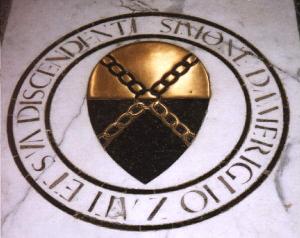 Arms of Simone d'Amerigho
Zati: Per pale or and sable, four chains in saltire linked by an
annulet, all counterchanged (Santa Croce, Florence). Note the refined
combination of black marble and brass to represent Or and Sable.
Arms of Simone d'Amerigho
Zati: Per pale or and sable, four chains in saltire linked by an
annulet, all counterchanged (Santa Croce, Florence). Note the refined
combination of black marble and brass to represent Or and Sable. Arms of Simone d'Amerigho
Zati: Per pale or and sable, four chains in saltire linked by an
annulet, all counterchanged (Santa Croce, Florence). Note the refined
combination of black marble and brass to represent Or and Sable.
Arms of Simone d'Amerigho
Zati: Per pale or and sable, four chains in saltire linked by an
annulet, all counterchanged (Santa Croce, Florence). Note the refined
combination of black marble and brass to represent Or and Sable.
 Curious triangular shield,
dated 1453. Santa Croce, Florence.
Curious triangular shield,
dated 1453. Santa Croce, Florence.
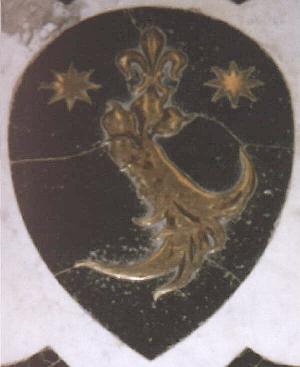 Tomb of Antonio de Salutati: Azure
a lion's paw holding a fleur-de-lys in chief between two stars of 8 points
all or (Santa Croce, Florence).
Tomb of Antonio de Salutati: Azure
a lion's paw holding a fleur-de-lys in chief between two stars of 8 points
all or (Santa Croce, Florence).
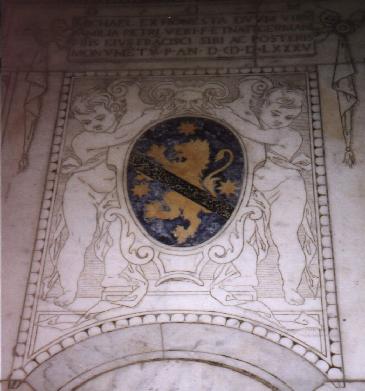 Another tomb in Santa Croce,
Florence, dated 1685. This Baroque shield is shown with two putti as supporters: they
are engraved in the surrounding marble.
Another tomb in Santa Croce,
Florence, dated 1685. This Baroque shield is shown with two putti as supporters: they
are engraved in the surrounding marble.
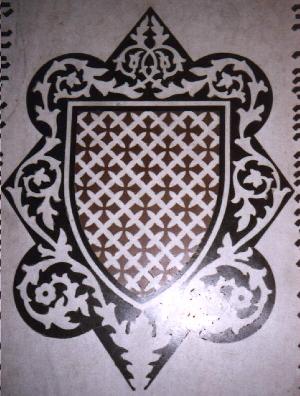 Tomb of the Cavalcanti
family, dated 1371: Argent a semy of crosslets bottony gules
(Santa Croce, Florence). Note the remarkable pattern.
Tomb of the Cavalcanti
family, dated 1371: Argent a semy of crosslets bottony gules
(Santa Croce, Florence). Note the remarkable pattern.
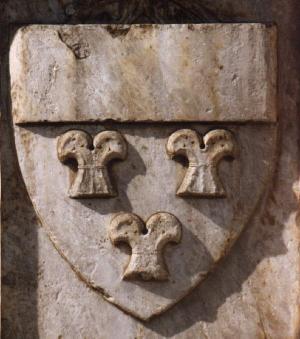 Arms of the Frescobaldi
(Gules three rooks argent and a chief or) on the facade of Santa Maria
Novella, Florence. I had the occasion to see a Medieval rook chess-piece
in ivory, which looked exactly like this charge.
Arms of the Frescobaldi
(Gules three rooks argent and a chief or) on the facade of Santa Maria
Novella, Florence. I had the occasion to see a Medieval rook chess-piece
in ivory, which looked exactly like this charge.
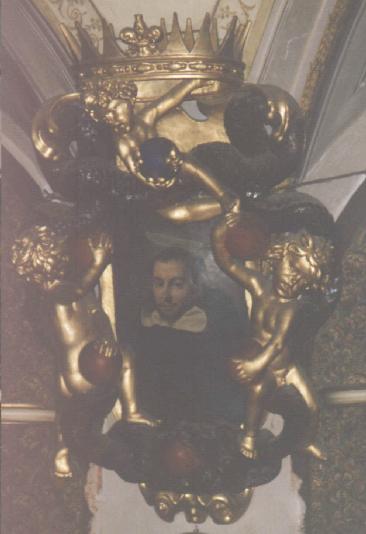 A splendid rendition of
the Medici arms as a portrait frame. Unfortunately, the image is dark,
but one can make out that three gilded putti are passing each other 5 red
balls and one blue ball, thus evoking the Medici arms. Pharmacy of Santa
Maria Novella, Florence.
A splendid rendition of
the Medici arms as a portrait frame. Unfortunately, the image is dark,
but one can make out that three gilded putti are passing each other 5 red
balls and one blue ball, thus evoking the Medici arms. Pharmacy of Santa
Maria Novella, Florence.
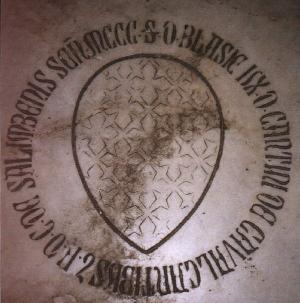 The Cavalcanti arms, in
a more ancient rendition (1310; Santa Maria Novella, Florence).
The Cavalcanti arms, in
a more ancient rendition (1310; Santa Maria Novella, Florence).
 The Pitti arms (barry
nebuly argent and sable, a crosslet and in chief a label gules), on
the facade of a building right across the street from the famous Palazzo
Pitti.
The Pitti arms (barry
nebuly argent and sable, a crosslet and in chief a label gules), on
the facade of a building right across the street from the famous Palazzo
Pitti.
 Interior courtyard of the
Bargello, Florence. This illustrates a widespread practice in Tuscany: governors,
captains of the people and other officials added their arms to the outside
and/or inside walls of the official building in which they were housed
during their tenure. As a result, many palazzi communali offer splendid
displays of (mainly 15th and early 16th c.) Italian heraldry.
Interior courtyard of the
Bargello, Florence. This illustrates a widespread practice in Tuscany: governors,
captains of the people and other officials added their arms to the outside
and/or inside walls of the official building in which they were housed
during their tenure. As a result, many palazzi communali offer splendid
displays of (mainly 15th and early 16th c.) Italian heraldry.
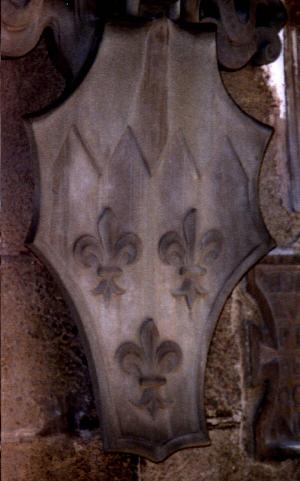 The typical testo di
cavallo shield (horse-head). Possibly the arms of Dinegro: Argent
three fleurs-de-lys azure and a chief emanché gules. Bargello,
Florence.
The typical testo di
cavallo shield (horse-head). Possibly the arms of Dinegro: Argent
three fleurs-de-lys azure and a chief emanché gules. Bargello,
Florence.
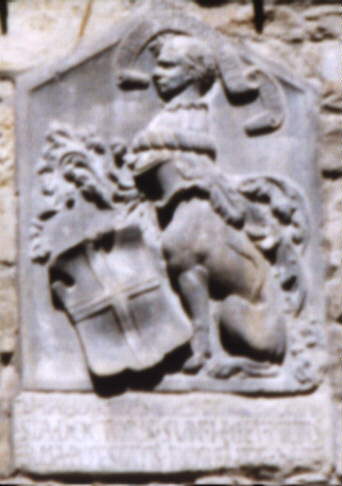 A very common combination
of a single supporter wearing the helm with a crest on top. Note the targe
or jousting shield, held at an angle. Italian achievements of the 15th
c. have a strong German flavor.
A very common combination
of a single supporter wearing the helm with a crest on top. Note the targe
or jousting shield, held at an angle. Italian achievements of the 15th
c. have a strong German flavor.
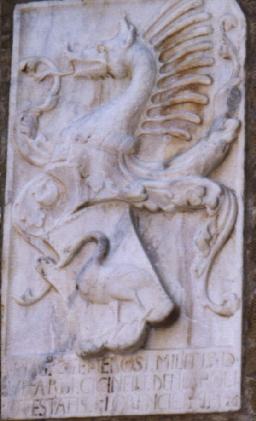 Arms of Budardo Cicinello
di Napoli: Gules a swan argent and a bordure indented or. Bargello,
Florence.
Arms of Budardo Cicinello
di Napoli: Gules a swan argent and a bordure indented or. Bargello,
Florence.
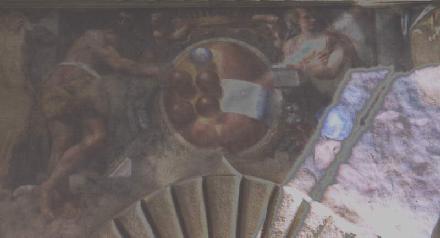 An interesting conceit: the
impaled arms of Medici and Austria have as supporters their owners: Ferdinando
of Medici and his wife Maria-Maddalena of Austria. On a graffiti facade,
via de Benci, Florence.
An interesting conceit: the
impaled arms of Medici and Austria have as supporters their owners: Ferdinando
of Medici and his wife Maria-Maddalena of Austria. On a graffiti facade,
via de Benci, Florence.
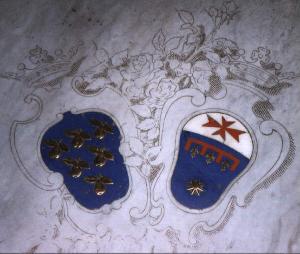 Beautiful inlaid marble
work of the 18th c., in the Peruzzi chapel adjacent to Santa Croce. Note
the canting Peruzzi arms (Azure six pears or). I have not identified
the wife's arms.
Beautiful inlaid marble
work of the 18th c., in the Peruzzi chapel adjacent to Santa Croce. Note
the canting Peruzzi arms (Azure six pears or). I have not identified
the wife's arms.
 To me, it's always been
obvious that the fleur-de-lys is really an iris.
To me, it's always been
obvious that the fleur-de-lys is really an iris.
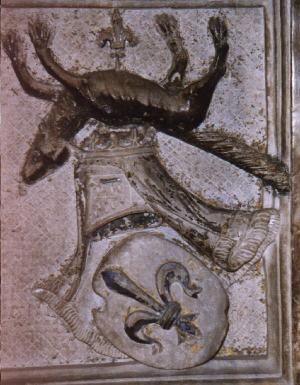 Curious crest! The arms
are Or a fleur-de-lys azure (the paint is still visible). Museo del Opera
del Duomo, Florence (these arms are actually sculpted on the side panel
of a Roman sarcophagus).
Curious crest! The arms
are Or a fleur-de-lys azure (the paint is still visible). Museo del Opera
del Duomo, Florence (these arms are actually sculpted on the side panel
of a Roman sarcophagus).
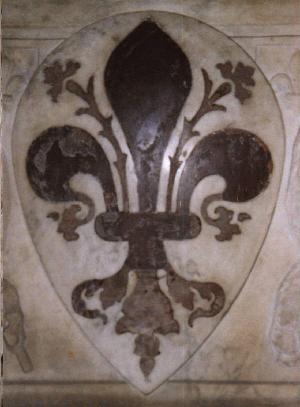 The Florentine fleur-de-lys
(Museo del Opera del Duomo, Florence).
The Florentine fleur-de-lys
(Museo del Opera del Duomo, Florence).
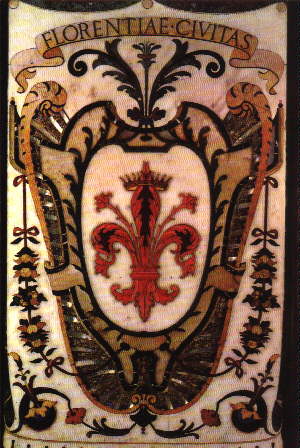 Arms of Florence, from
the Capella Medicea (burial place of the grand-dukes), S. Lorenzo, Florence.
Arms of Florence, from
the Capella Medicea (burial place of the grand-dukes), S. Lorenzo, Florence.
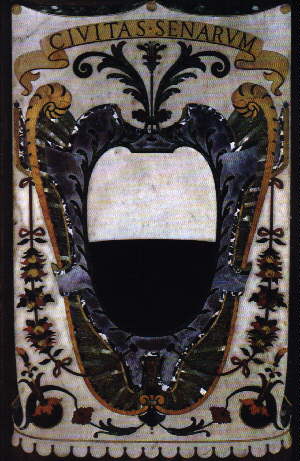 Arms of Siena, same location.
Arms of Siena, same location.
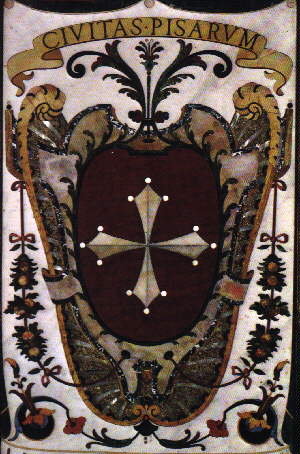 Arms of Pisa, same location.
All three works are in pietre dure, i.e., marble mosaic.
Arms of Pisa, same location.
All three works are in pietre dure, i.e., marble mosaic.
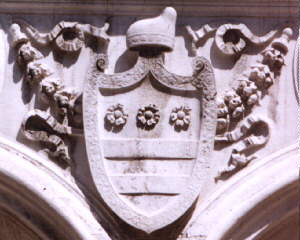 Arms of Donato (Argent
two bars and in chief three roses gules), surmounted by the doge's
crown. Note the typical Venitian shield. From the courtyard of the Palazzo
Ducale, Venice.
Arms of Donato (Argent
two bars and in chief three roses gules), surmounted by the doge's
crown. Note the typical Venitian shield. From the courtyard of the Palazzo
Ducale, Venice.
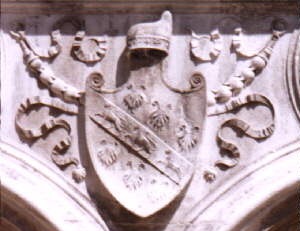 Arms
of Barbarigo (Argent on a bend azure between six beards sable three
lions passant or). The beards are canting, obviously. From the courtyard
of the Palazzo Ducale, Venice.
Arms
of Barbarigo (Argent on a bend azure between six beards sable three
lions passant or). The beards are canting, obviously. From the courtyard
of the Palazzo Ducale, Venice.
 Arms
of Priuli (pally of six or and azure and a chief gules), from the
Palazzo Ducale, Venice. As is often the case in Italian heraldry, the chief
is oversized.
Arms
of Priuli (pally of six or and azure and a chief gules), from the
Palazzo Ducale, Venice. As is often the case in Italian heraldry, the chief
is oversized.
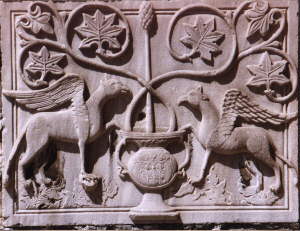 A relief from the southern
wall of San Marco, Venice. Probably 12th c. Byzantine. A nice illustration
of the old Middle Eastern theme of the tree of life with two animals affrontes
(here, griffins). Such motifs were already common in pre-heraldic Europe
because of the Crusades.
A relief from the southern
wall of San Marco, Venice. Probably 12th c. Byzantine. A nice illustration
of the old Middle Eastern theme of the tree of life with two animals affrontes
(here, griffins). Such motifs were already common in pre-heraldic Europe
because of the Crusades.
 The very striking arms
of the Malipiero family, from a Gothic portal near the San Tome vaporetto
station. The blazon in Freschot's Nobiltà Veneta (1680)
is d'argento con un artiglio e ala d'aquila
negra, while in Ginnani's Arte del Blasone (1756) it is:
d'argento un mezzo volo destro spiegato di nero e sostenuto da un'artiglio
del medesimo. Rietstap calls the whole charge a main d'aigle
(literally eagle-hand), and Woodward a winged hand (he claims that it was
originally an eagle's thigh with tufts attached, which later evolved into
a wing). It is found in Iberian, German and Italian heraldry (over 50 examples
in Rietstap, although some represent a hand with a wing, which is not the
same thing as what we see here; perhaps Rietstap is confusing different
charges).
The very striking arms
of the Malipiero family, from a Gothic portal near the San Tome vaporetto
station. The blazon in Freschot's Nobiltà Veneta (1680)
is d'argento con un artiglio e ala d'aquila
negra, while in Ginnani's Arte del Blasone (1756) it is:
d'argento un mezzo volo destro spiegato di nero e sostenuto da un'artiglio
del medesimo. Rietstap calls the whole charge a main d'aigle
(literally eagle-hand), and Woodward a winged hand (he claims that it was
originally an eagle's thigh with tufts attached, which later evolved into
a wing). It is found in Iberian, German and Italian heraldry (over 50 examples
in Rietstap, although some represent a hand with a wing, which is not the
same thing as what we see here; perhaps Rietstap is confusing different
charges).
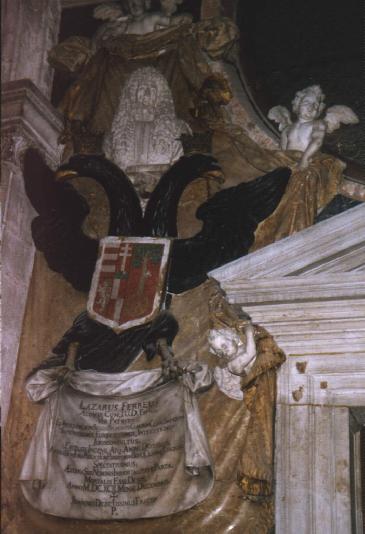 A grandiose Baroque tomb
in Venice (San Marco?). The deceased is Lazaro Ferro (died 1692), and the
arms are: Argent a double-headed eagle displayed sable, armed,
beaked and each head crowned or; on its breast an escutcheon: per
pale, I. quarterly, 1. barry argent and gules, 2. gules a patriarchal cross
argent on a mount vert, 3. gules a lion argent crowned or, and 4. quarterly
argent and gules; II. Gules on a wheel or a tree vert climbing thereon
at dexter a woodpecker proper. The Imperial eagle and the quarters
of Hungary and Bohemia were a concession of the emperor Frederic III (1440-93).
A grandiose Baroque tomb
in Venice (San Marco?). The deceased is Lazaro Ferro (died 1692), and the
arms are: Argent a double-headed eagle displayed sable, armed,
beaked and each head crowned or; on its breast an escutcheon: per
pale, I. quarterly, 1. barry argent and gules, 2. gules a patriarchal cross
argent on a mount vert, 3. gules a lion argent crowned or, and 4. quarterly
argent and gules; II. Gules on a wheel or a tree vert climbing thereon
at dexter a woodpecker proper. The Imperial eagle and the quarters
of Hungary and Bohemia were a concession of the emperor Frederic III (1440-93).
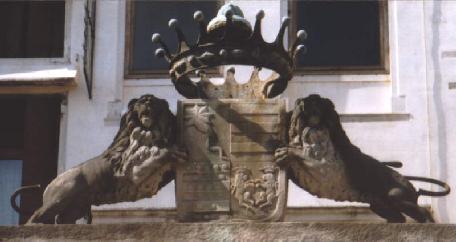 Arms of counts Michieli: Quarterly
1. Azure a comet in bend or, 2. barry of six azure and argent, 3. barry
of six azure and argent with 12 bezants placed 6, 4, 2 and 9 hurts placed
5, 3 and 1, 4. azure two lions affrontés crowned or "jouant
de la patte" (according to Riestap!). I surmise that
the dogal crown set within the comital crown is an allusion to the fact
that the family counted doges among its members. Stylistically, I'd date
it to the 18th c. (Str. Nuova, Venice).
Arms of counts Michieli: Quarterly
1. Azure a comet in bend or, 2. barry of six azure and argent, 3. barry
of six azure and argent with 12 bezants placed 6, 4, 2 and 9 hurts placed
5, 3 and 1, 4. azure two lions affrontés crowned or "jouant
de la patte" (according to Riestap!). I surmise that
the dogal crown set within the comital crown is an allusion to the fact
that the family counted doges among its members. Stylistically, I'd date
it to the 18th c. (Str. Nuova, Venice).
 A nice 15th c. shield,
over a side door of the Michieli palace. D. Casimiro Freschot, in his Nobilta
Veneta (1680, p. 371; reprint Arnaldo Forni) mentions that the crest
of the Michieli is the archangel Michael holding a sword, but that "in
un marmo antico sù la porta di un palazzo di questa Casa, l'angelo
è coronato, e in vece di spada tiene un scettro sormontato con un
giglio, che può esser una concessione di Fancia à qualche
ambasciatore" (on an ancient marble over the door of a palace of this
house the angel is crowned, and instead of a sword he holds a scepter surmounted
bya fleur-de-lys, which may be a concession of France to some ambassador).
A nice 15th c. shield,
over a side door of the Michieli palace. D. Casimiro Freschot, in his Nobilta
Veneta (1680, p. 371; reprint Arnaldo Forni) mentions that the crest
of the Michieli is the archangel Michael holding a sword, but that "in
un marmo antico sù la porta di un palazzo di questa Casa, l'angelo
è coronato, e in vece di spada tiene un scettro sormontato con un
giglio, che può esser una concessione di Fancia à qualche
ambasciatore" (on an ancient marble over the door of a palace of this
house the angel is crowned, and instead of a sword he holds a scepter surmounted
bya fleur-de-lys, which may be a concession of France to some ambassador).
 Very curious inlaid marble
shield in San Zaccaria, Venice. Note that the shape of the shield is distinctly
Venitian. I'm not sure if the charge is a horse or a lion, and it is definitely
chequy or and azure. Probably Medieval.
Very curious inlaid marble
shield in San Zaccaria, Venice. Note that the shape of the shield is distinctly
Venitian. I'm not sure if the charge is a horse or a lion, and it is definitely
chequy or and azure. Probably Medieval.